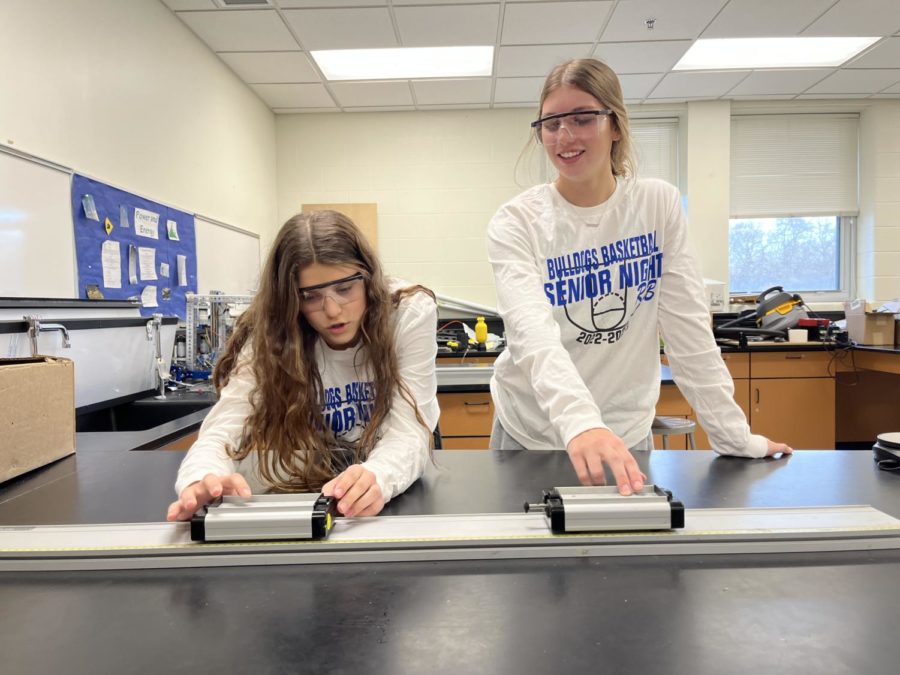Behind the “Women in STEM” statement
Niamh Larson (left) and Emily Organ (right) work on a science lab project. Photo taken by Nikki Tinerella.
December 9, 2022
In 1952, the first photo of DNA was taken. Through the use of X-ray crystallography, the photograph confirmed that DNA contained two chains of nucleotide pairs that encode the genetic information for all living things.
Two male scientists were credited for the discovery of DNA’s structure, and they soon advanced and proposed that DNA had a helical structure, similar to a staircase. That photograph was taken by a third scientist, and their research was disclosed to the individuals credited for the discovery.
Two out of the three scientists who contributed to this discovery were awarded for their analysis on the double helix structure of DNA, but that third individual was not rewarded; however, through time, she came to be known as the woman who took the first photo of DNA, Dr. Rosalind Franklin.
Today, women in science, technology, engineering, and mathematics (STEM) fields have also faced similar challenges as Dr. Franklin did. Their work and research had been credited to the hands of men and are demeaned for their contributions as well as effort. Women in this industry often have to work harder for what they want and are undermined for their endeavors and performance. As a woman aspiring to work in computer science, this problem needs to be addressed and a solution needs to be found.
Across history, the fields of STEM have been noted to be predominantly male, while women have had a moderate participation in the field. In relation to Franklin, women have been underrepresented in the STEM field. 25 percent of the individuals working in the field are women, and that number does not account for the lack of diversity in the industry! Only five percent of the industry are Asian, three percent are Black and Latina, and half a percent are Native American. These disparaging numbers account for the limited perspectives in the STEM industry, and I believe that distinct and divergent cultures are what the STEM field needs.
By taking into account diversity, people from contrasting backgrounds can bring in new ideas and developments in industry. The STEM industry is huge on making new developments through discovering new ways and ideas on how work can be more efficient. New ways of thinking can be constructed through diverse experiences, and by promoting diversity in the STEM industry, new developments can be tailored accordingly to a range of people. Bringing a diversity of people into this field can open new doors and opportunities for a spectrum of individuals, and this is a significant factor within the STEM industry.
I believe that the absence of diversity in working industries is something that impacts the company. The gender gap is a huge contributor to the scarce numbers of men and women, and this has created a challenge for women across the globe.
Even outside of the STEM field, women are treated differently in ethics and pay due to their gender. More often than not, women are discredited for their work solely because of their gender. As the gender gap increases, this field is disparaging with women being the minority. Working in a field that is dominated by men is extremely discouraging. Numerous women across history and today have encountered gender inequity in the industry, specifically in the workplace.
Gender inequity in the STEM industry is a detrimental factor in the workplace. From my perspective, the work environment is crucial for my work ethic. If the relationship between my co-workers and I is averse, that’s where I begin to see my career as more of a job.
Genuinely, I aim to see my job as something I enjoy rather than loathe. There are so many individuals who endure their work environment for pay, and I don’t blame them! If being the only woman in the workplace is going to get the bills paid, then I’ll continue to work; however, if there’s a pay gap between men and women, then there is an issue. The disparity among the pay of men and women has been a factor within STEM careers, and as more awareness has spread regarding this issue, little change has been made. Considering the impact of the gender gap, it is a huge element in regards to stereotypes.
Developing stereotypes in any sector is undeniably disgusting. Depending on the career within the STEM field, “bro”-related stereotypes have been developed (“tech bro,” “finance bro,” etc.). “Bro” stereotypes have been developed to label and describe a “typical” man within the STEM field, and recently, stereotypes for women in STEM have been introduced.
Now that women are aiming to work in the STEM industry, people have taken the opportunity to create stereotypes about them. The entire prospect of stereotypes is absolutely loathsome, and the “bro” culture, honestly, needs to be scrapped. These stereotypes are highlighted at universities and in the workforce, but those stereotypes don’t account for the disproportion of men and women in the industry.
I wasn’t introduced to the reality of the STEM industry until I took my first computer science course. Only a few girls were in the class, and I believed that the notion of empowerment and diversity was well-known, but I was completely wrong. Previously, I had attended computer science-related extracurriculars and taken a camp during the summer, but in both those extracurriculars and at that camp I was surrounded by a handful of women. I was educated on gender disparity during my time in both experiences, and I aim to continue to understand the concept as time progresses; however, I believed that those statements were slightly over exaggerated–I was wrong.
I find it concerning that women have to work for representation when they should’ve been treated the same from the beginning! Almost the entire concept of “women in STEM” was developed to derive representation from the STEM field since women were being treated differently and disrespected all because of their gender. Men dominated the industry, and from time to time, women would be seen working in the field, but they were often singled out since they were the only women in the lab or workshop. If we want change to occur, then we have to work for it.
I believe that it’s our responsibility, as the next generation, to foster and empower more women into the field. Steps have been taken to advocate for women in STEM on social media. People have taken measures to empower and represent a diversity of women to pursue a career in this field. Numerous clubs and organizations have aimed to provide a space where women and non-binary individuals can be empowered alongside other people who are facing the same issue. For me, seeing other women prosper even when they are discouraged at the beginning of their journey is truly inspiring.
Overall, the concept of women in STEM should be accepted, and women should have their opportunity to be represented in this male-dominated field. Truly, I am sick and tired of the baggage women carry in order to have a career in this industry. If people have a passion within this field and work to their goal, why should they be discouraged? Gender bias is frankly a detrimental and damaging aspect of STEM careers, particularly for women, and we can thank men for that! Women are outnumbered by men in the STEM field, and that issue is specifically brought on by a bias for a factor that cannot be altered: their gender. In retrospect, for change to change to transpire, small steps should be taken in this long journey. However, this journey has already begun, through the spread of representation and empowerment in the STEM field, change can ensue and make a difference for women across the globe.




